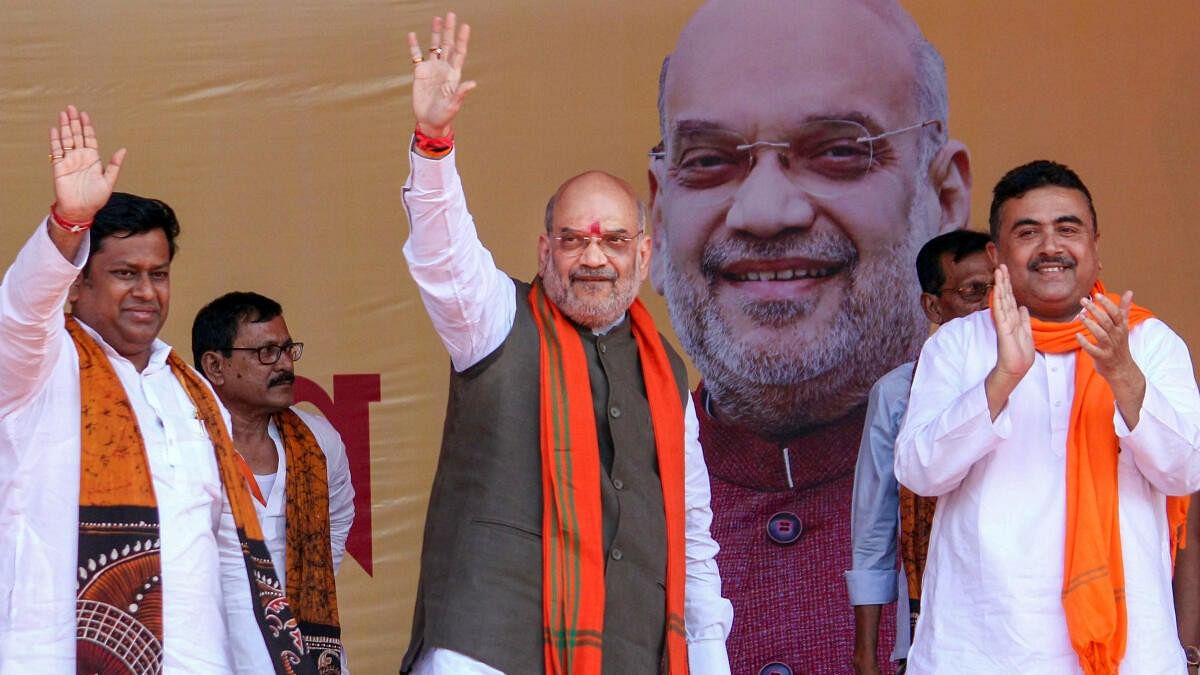
Union Home Minister Amit Shah with BJP WB President Sukanta Majumdar and party leader Suvendu Adhikari.
Credit: PTI Photo
Proposals to dismember West Bengal one way or another have been slung around with abandon in the aftermath of the new dispensation’s July 23rd Union Budget.
Sukanta Majumdar, Union minister of state for the development of the northeast region and outgoing West Bengal Bharatiya Janata Party (BJP) president, set the ball rolling the day after the Budget speech, with the demand that the eight districts in West Bengal’s north be clubbed with the northeastern region for development. He made a presentation to Prime Minister Narendra Modi, and later said: ‘I proposed that these districts be included in the list for the northeastern states.’
The next day there was a mixed reception to this proposal among West Bengal BJP leaders, with party spokesman Samik Bhattacharya clarifying that the party believed in the development of the state without altering its boundaries. But Godda MP Nishikant Dubey was quick to roil troubled waters. On July 25, he first said that the Muslim population of Jharkhand was increasing due to the infiltration of Bangladeshis from Malda and Murshidabad districts, proposing that they be converted into Union Territories. He alleged that Muslim men were entering the Santhal Parganas, marrying Jharkhandi women and settling in the state.
This is a figment of Dubey’s imagination, and the proposed solution is risible. Besides, if Dubey is so concerned about the demographics of the Santhal Parganas, and Chotanagpur, for that matter, he needs a history lesson that will tell him that non-tribal people are interlopers. The autochthons fought against infiltration by the dikus (outsiders), before being reduced to a minority in their homelands.
It didn’t take long for Dubey’s proposal to get fresh legs. The day after, BJP MLA from Murshidabad Gouri Shankar Ghosh also demanded that his district be converted into a Union Territory, which he claimed he’d been advocating since 2022.
The reason for wanting the vivisection of West Bengal was that there was, supposedly, infiltration into the district by Bangladeshis, including a contingent of jihadists. Responding to these fantasists is unnecessary. In any case, the Border Security Force (BSF) answers to the Ministry of Home Affairs, so, perhaps, these allegations are pointed towards Union Home Minister Amit Shah.
On July 28, Subrata Maitra, a BJP MLA from Berhampore, echoed these demands, pitching for a transfer to the Centre of administrative control over the districts of Malda, Murshidabad, Uttar and Dakshin Dinajpur, and Nadia, again to check infiltration from Bangladesh. Maitra disingenuously said he wasn’t asking for separate states, but his proposal is constitutionally nonsensical.
On the same day, Jayanta Kumar Roy, an MP from Jalpaiguri district, repeated Majumdar’s proposal, though he was equivocal about vivisection. Roy’s attempt to strike a balance exposes the BJP’s strategy of running with the hare and hunting with the hounds. On the one hand, some members try to foment divisiveness, while others, apparently, commit themselves to the status quo. It’s anybody’s guess what the party’s real policy is because the party’s central leadership maintains a gnomic silence.
Unsurprisingly, at the bottom of this rash of proposals is the demonisation of the Muslim community and attempts to stoke division, as Leader of the Opposition Suvendu Adhikari made plain on July 28 when he said his party should concentrate on getting 5% more of Hindu votes for the 2026 Assembly elections.
It was Adhikari, though, who disavowed the demands on the floor of the Legislative Assembly the very next day, describing them as personal views and iterating the BJP’s position, which was that it did not want the partition of West Bengal. Whom should we believe? The state president of the party or the Leader of the Opposition?
The Trinamool Congress (TMC) excoriated the BJP for its calls to divide the state, inside the Assembly and outside it, with Chief Minister Mamata Banerjee leading the charge. The TMC will try to maximise the advantage afforded by loose tongues. It is almost a certainty that the people of no part of West Bengal want to separate from the state, with the exception at best of the people in the Darjeeling hill regions, who have for long been advocating for Gorkhaland. Not even the Kamtapur movement centred in the Cooch Behar district has substantial traction.
This is why all this divisive brinkmanship allied to specious disavowals cannot hide the leaderless state of disarray in the West Bengal BJP. It’s clear that the duumvirate that runs the party is scraping the bottom of an already scoured barrel to identify a replacement for Majumdar.
(Suhit K Sen is author of ‘The Paradox of Populism: The Indira Gandhi Years, 1966-1977’.)
Disclaimer: The views expressed above are the author's own. They do not necessarily reflect the views of DH.